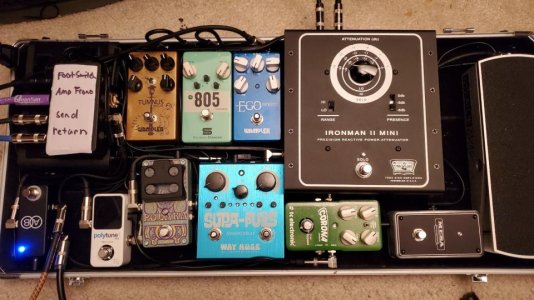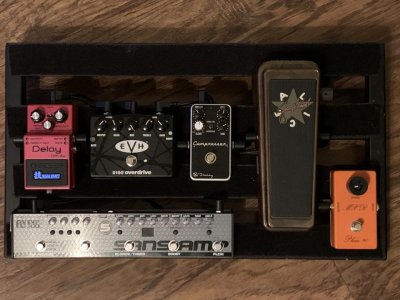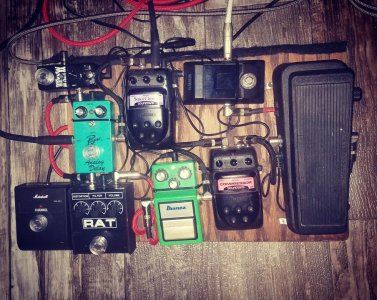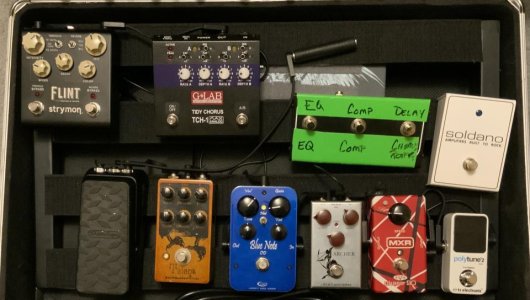You are using an out of date browser. It may not display this or other websites correctly.
You should upgrade or use an alternative browser.
You should upgrade or use an alternative browser.
Lets see those pedal boards you are using right now.
- Thread starter guitarSQUIRELL
- Start date
Artie
Peaveyologist
Got the Ironman II Mini on the board (somehow lol).
That's a "mini"! That looks lethal. What does it do?
That's a "mini"! That looks lethal. What does it do?
It's a reactive amp attenuator. It's purpose is to preserve the amp tone at lower volumes, mostly for running amps mostly cranked to get that sweet tone without waking the dead. This is the "mini" version designed for up to 30W amps. The regular goes up to 100W, but it was more than I wanted to spend. In hindsight, it probably would have been more convenient because of the solo switch it has lol.
Oh well, everything fits and I have no desire for more pedals.
Artie
Peaveyologist
It's a reactive amp attenuator. It's purpose is to preserve the amp tone at lower volumes, mostly for running amps mostly cranked to get that sweet tone without waking the dead. This is the "mini" version designed for up to 30W amps. The regular goes up to 100W, but it was more than I wanted to spend. In hindsight, it probably would have been more convenient because of the solo switch it has lol.
Oh well, everything fits and I have no desire for more pedals.
That's cool. 30 watts would be perfect for me. Yet another thing for me to look into.
That's cool. 30 watts would be perfect for me. Yet another thing for me to look into.
Good deal and good luck with your search!
dystrust
Well-known member
Pedalboard v7:

While playing around with my new Z.Vex Octane I discovered that it REALLY likes to be gain-staged, and it sounds a lot better before my Tube Screamer than after. On a whim I swapped positions of my UFO & Tumnus, and holy sh!t did it make a difference. Not only is UFO -> Tumnus a cool sound when playing on the clean channel, the UFO seems to HATE the Tumnus buffer. The UFO was really picky about pickup settings and playing dynamics with the prior pedal order, but those issues are in the past now. Not much of an update per-se, but a definite improvement as far as sound quality and flexibility.
The board is a Holeyboard Evolution Wide; power courtesy of a Voodoo Lab Pedal Power Mondo.
Signal flow is set up to mimic a two-amp rig I had briefly in the mid 2000s.
Guitar -> EB Volume -> Wah -> EVH Phase 90 -> Loop-Master Clean/Dirty/Channel Switcher™ w/Combinable Loops & Tuner Out
Dirty: UFO (fuzz / octave) -> Tumnus -> Micro Flanger -> Flashback 2 (Dynamic ~300ms)
Clean: MIJ CS-3 -> GT-500 -> MIJ CE-2 -> Flint
Tuner: Korg Pitchblack Portable
When combined, the dirty loop is cascaded into the clean loop. The signal and switch outputs from the Loopmaster go to a junction box hidden under the left end of the riser.
longcat board V4:

This update was all about flexibility and options. The Pickle Pie is an awesome bass Muff, but it doesn't do subtle very well. Enter the Darkglass Vintage Microtubes tubes, essentially the Moving Pictures overdriven bass tone in a box. Instead of simple cleanish / really dirty, now longcat has cleanish, punchy overdrive (Microtubes), heavy & thick (Pickle Pie), and insanely over-the-top (Microtubes -> Pickle Pie). The Pitchblack no longer fit on the board, but a friend's shop just happened to have a Pitchblack Mini in limited edition purple.
The board is a Holeyboard Evo amptop; power courtesy of a Voodoo Lab Pedal Power 2 Plus located under the board.
Signal chain is: Pitchblack Mini -> Octave -> Retro-Sonic -> Vintage Microtubes -> Pickle Pie B -> CE-2B -> BF-2
Original NPBD here, while v2 is here, v3 is here, v4 is here, v5 is here, and v6 is here.

While playing around with my new Z.Vex Octane I discovered that it REALLY likes to be gain-staged, and it sounds a lot better before my Tube Screamer than after. On a whim I swapped positions of my UFO & Tumnus, and holy sh!t did it make a difference. Not only is UFO -> Tumnus a cool sound when playing on the clean channel, the UFO seems to HATE the Tumnus buffer. The UFO was really picky about pickup settings and playing dynamics with the prior pedal order, but those issues are in the past now. Not much of an update per-se, but a definite improvement as far as sound quality and flexibility.
The board is a Holeyboard Evolution Wide; power courtesy of a Voodoo Lab Pedal Power Mondo.
Signal flow is set up to mimic a two-amp rig I had briefly in the mid 2000s.
Guitar -> EB Volume -> Wah -> EVH Phase 90 -> Loop-Master Clean/Dirty/Channel Switcher™ w/Combinable Loops & Tuner Out
Dirty: UFO (fuzz / octave) -> Tumnus -> Micro Flanger -> Flashback 2 (Dynamic ~300ms)
Clean: MIJ CS-3 -> GT-500 -> MIJ CE-2 -> Flint
Tuner: Korg Pitchblack Portable
When combined, the dirty loop is cascaded into the clean loop. The signal and switch outputs from the Loopmaster go to a junction box hidden under the left end of the riser.
longcat board V4:

This update was all about flexibility and options. The Pickle Pie is an awesome bass Muff, but it doesn't do subtle very well. Enter the Darkglass Vintage Microtubes tubes, essentially the Moving Pictures overdriven bass tone in a box. Instead of simple cleanish / really dirty, now longcat has cleanish, punchy overdrive (Microtubes), heavy & thick (Pickle Pie), and insanely over-the-top (Microtubes -> Pickle Pie). The Pitchblack no longer fit on the board, but a friend's shop just happened to have a Pitchblack Mini in limited edition purple.
The board is a Holeyboard Evo amptop; power courtesy of a Voodoo Lab Pedal Power 2 Plus located under the board.
Signal chain is: Pitchblack Mini -> Octave -> Retro-Sonic -> Vintage Microtubes -> Pickle Pie B -> CE-2B -> BF-2
Original NPBD here, while v2 is here, v3 is here, v4 is here, v5 is here, and v6 is here.
Last edited:
ErikH
Well-known member
Put this together to use with the Journey Tribute band. A buddy of mine gave me the Pedaltrain. The Pedal Snake is great. One cable from the board to the back. The Phase 90 is first in line because it doesn't run on plug-in power, battery only. Don't have to worry about forgetting to unplug the input so the battery doesn't drain.
Revision. The Soul Food is gone. I got the EVH 5150 Overdrive for Christmas. The Fly Rig 5 v2 is great. Can run it direct to the board via XLR and to an amp or another powered speaker or another mixer via 1/4" out (amp sim can be enabled/disabled on this one). For rehearsals I take just the Fly Rig and 5150 Overdrive. This board setup is for when we can finally get to play out live again.
Attachments
v8stang289
Well-known member
Pedalboard v7:

While playing around with my new Z.Vex Octane I discovered that it REALLY likes to be gain-staged, and it sounds a lot better before my Tube Screamer than after. On a whim I swapped positions of my UFO & Tumnus, and holy sh!t did it make a difference. Not only is UFO -> Tumnus a cool sound when playing on the clean channel, the UFO seems to HATE the Tumnus buffer. The UFO was really picky about pickup settings and playing dynamics with the prior pedal order, but those issues are in the past now. Not much of an update per-se, but a definite improvement as far as sound quality and flexibility.
The board is a Holeyboard Evolution Wide; power courtesy of a Voodoo Lab Pedal Power Mondo.
Signal flow is set up to mimic a two-amp rig I had briefly in the mid 2000s.
Guitar -> EB Volume -> Wah -> EVH Phase 90 -> Loop-Master Clean/Dirty/Channel Switcher™ w/Combinable Loops & Tuner Out
Dirty: UFO (fuzz / octave) -> Tumnus -> Micro Flanger -> Flashback 2 (Dynamic ~300ms)
Clean: MIJ CS-3 -> GT-500 -> MIJ CE-2 -> Flint
Tuner: Korg Pitchblack Portable
When combined, the dirty loop is cascaded into the clean loop. The signal and switch outputs from the Loopmaster go to a junction box hidden under the left end of the riser.
longcat board V4:

This update was all about flexibility and options. The Pickle Pie is an awesome bass Muff, but it doesn't do subtle very well. Enter the Darkglass Vintage Microtubes tubes, essentially the Moving Pictures overdriven bass tone in a box. Instead of simple cleanish / really dirty, now longcat has cleanish, punchy overdrive (Microtubes), heavy & thick (Pickle Pie), and insanely over-the-top (Microtubes -> Pickle Pie). The Pitchblack no longer fit on the board, but a friend's shop just happened to have a Pitchblack Mini in limited edition purple.
The board is a Holeyboard Evo amptop; power courtesy of a Voodoo Lab Pedal Power 2 Plus located under the board.
Signal chain is: Pitchblack Mini -> Octave -> Retro-Sonic -> Vintage Microtubes -> Pickle Pie B -> CE-2B -> BF-2
Original NPBD here, while v2 is here, v3 is here, v4 is here, v5 is here, and v6 is here.
Nice to see another UFO! I've had one on my board for the last decade. Lots of others have come and gone but I still haven't found a better sounding fuzz than that.
Cool board!
Spirit of 76
New member
That's a "mini"! That looks lethal. What does it do?
Right! If that's a mini, those are some tiny pedals lol.
Seriously, you did a good job fitting everything in and optimizing the space.
NegativeEase
New member
The integration is so tight with this one... This is surely a triumph of our thread!
I'm rebuilding my board today -will post.
Aceman
I am your doctor of love!
So you did that now, did you?
Aceman
I am your doctor of love!
Agileguy_101;n5693685 [ATTACH=CONFIG said:102836[/ATTACH]
OK. This is the "Lets see the BOARD" thread. In a drawer? Really? Pretentious mother ^%#^$%#. You better be on tour with a stadium band.
Aceman
I am your doctor of love!
Agileguy_101;n5693685 [ATTACH=CONFIG said:102836[/ATTACH]
OK. This is the "Lets see the BOARD" thread. In a drawer? Really? Pretentious mother ^%#^$%#. You better be on tour with a stadium band.
Aceman
I am your doctor of love!
Re: Lets see those pedal boards you are using right now.
I'm curious about that green PSU. What brand is it?
Completely wrong orientation. Makes board completely unusable.
DKSEARS
New member
Here’s my most recent version.
A couple of notes
All powered by Walrus Audio power supply underneath the board.
The Blue Note and Talons move in and out depending on what amp I’m using (alternate out for MXR CBA Overdrive and MXR 78 Distortion).
The black and green pedal controls post effects in the presets from my UA OX when going direct.
The Soldano switcher pictured is routinely swapped out for the channel switcher for other amps.
The two pedals in the upper left are normally dedicated to the amps’ effects loop, but can be routed off the line from the volume pedal.
A couple of notes
All powered by Walrus Audio power supply underneath the board.
The Blue Note and Talons move in and out depending on what amp I’m using (alternate out for MXR CBA Overdrive and MXR 78 Distortion).
The black and green pedal controls post effects in the presets from my UA OX when going direct.
The Soldano switcher pictured is routinely swapped out for the channel switcher for other amps.
The two pedals in the upper left are normally dedicated to the amps’ effects loop, but can be routed off the line from the volume pedal.
Attachments
NegativeEase
New member
Here’s my most recent version.
A couple of notes
All powered by Walrus Audio power supply underneath the board.
The Blue Note and Talons move in and out depending on what amp I’m using (alternate out for MXR CBA Overdrive and MXR 78 Distortion).
The black and green pedal controls post effects in the presets from my UA OX when going direct.
The Soldano switcher pictured is routinely swapped out for the channel switcher for other amps.
The two pedals in the upper left are normally dedicated to the amps’ effects loop, but can be routed off the line from the volume pedal.
Can you elaborate on you UA OX use? Is it used for DI recording or reduced volume only or in your live rig too -or how exactly?
DKSEARS
New member
Can you elaborate on you UA OX use? Is it used for DI recording or reduced volume only or in your live rig too -or how exactly?
Sure.
I’m currently using the OX two ways.
Since I don’t do any recording, it is an integral part of my live rig, mostly for worship services currently since my bands are pretty much on COVID hiatus. It allows me to run direct and use IEMs at church including it’s built in effects (delay, chorus, compression and post eq) and if I’m outside of there I can use it for a direct FOH feed and pass a lower volume to my cabinet as needed, or bypass the cab emulation and use it to just reduce volume.
I also use it to reduce volume for times I want to run my amps at home.
However, I have seen several people locally using them in recording studios and the OX specific Facebook page is full of examples where people are using it as a direct recording unit.
Similar threads
- Replies
- 7
- Views
- 321
- Replies
- 18
- Views
- 469
- Replies
- 82
- Views
- 2K





